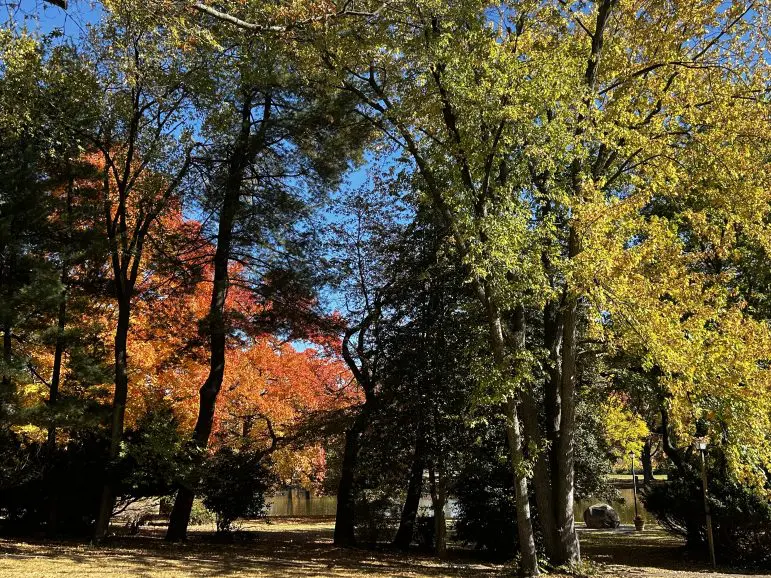When South Orange Village revamped its tree ordinance in November, it was touted as a way to lose fewer trees and replace more trees, ensuring its shady tree canopy stays robust for generations to come. But South Orange resident Michael Parlapiano has been crunching the numbers and shared data with The Village Green and the Village Council this week that he said shows that the new law may not protect the tree canopy as much as Council members thought it would.
Using the open records act, Parlapiano pulled the tree removal permits for all of 2024 and the second half of 2023, showing that in the second half of 2024, property owners cut down 256 trees and in the first half of the year, they cut down 180. Additionally, in the second half of 2023, he said, permit records show that 252 trees were cut down. In applying both two ordinance requirements to the permits, he said, he learned that if the new ordinance had been in place for just the last six months of 2024, it would’ve required the planting of 13 fewer trees than the old ordinance required for the same time period.
The old ordinance required that trees chopped down on lots larger than ½ acre be replaced or $175 payment per tree be made to a tree replacement fund. The new ordinance, which took effect at the end of November, eliminates the ½-acre threshold and requires the replacement of any healthy tree, but exempts the replacement of trees that are dead, diseased or dangerous.

South Orange Village’s revamped tree ordinance looks to preserve its beautiful trees and plant more for future generations. (Photo by Laura Griffin)
RELATED: South Orange Revamping Tree Ordinance to Ensure a Shady Canopy for Generations to Come
“When you look at the permits, almost every tree people take down is for one of those reasons,” Parlapiano said, adding that in the last half of 2024, only four permit applications might have required replacement under the new ordinance because they were healthy trees being cut down because they were too close to homes or garages or under a power line.
“It wouldn’t be a stretch to argue that in each of these cases, these [trees] may have posed a danger and therefore also been exempt from replacement,” he told the Council at its regular meeting on Monday, January 13.. “…I hope it wasn’t the intention of the administration and the Council when you adopted this new ordinance to reduce the number of replacement trees that were being planted. And I urge you to revisit the ordinance and correct mistakes. In particular, I urge you to require that every tree cut down on private property be replaced on that property as much as possible.”
Parlapiano also urged the Council to create incentives like waiving the permit fee for homeowners who replant a tree on site.
“A one-inch diameter tree can be purchased for about a hundred dollars. So a homeowner could look at it and say, I can either pay for the permit or I can plant a tree, and there’ll be an incentive for them to just plant the tree. I urge you to dedicate the tree fund to the planting of trees on private property and not to continue to use that money to plant street trees,” he said.
Council members Bill Haskins and Olivia Lewis-Chang, who both worked on the new ordinance, said since the law just went into effect in November, they want to give it more time to see how it is working because the permitting process gives the Village an opportunity to educate homeowners about the importance of trees and to try to prevent healthy trees from being cut down in the first place.
“We went into it with our best intentions as a group,” Haskins said. “I don’t know if we got it right, but if we didn’t, we can change it. But we’ll see what happens over the first half of this year. Hopefully we’ll have reduced numbers of trees cut down because we have good engagement with folks and give them some guidance.”
RELATED: South Orange Strengthens Tree Ordinance to Ensure Lost Trees are Replaced
Both Haskins and Lewis-Chang said they had seen the data that Parlapiano provided and they are taking it seriously.
“The most striking thing to me is just the number of trees that are cut down on private property and that, whether under the old ordinance or the new ordinance, that replacement is at 10 or 15% under either scenario,” Haskins said. “So we definitely have a challenge here.”
Lewis-Chang said she has noted Parlapiano’s observations and will review the data with the environmental commission, which also played a role in creating the new ordinance.
“This is a working and living document, and it’s subject to change if we have things askew,” Lewis-Chang said. “I’d like to see if some of those numbers remain the same or what happens in the next four months. …We’re gonna monitor it, so it’s not a dead issue.”

